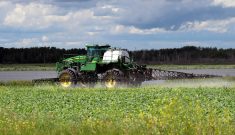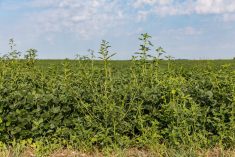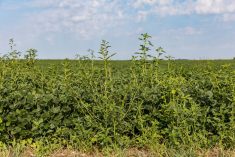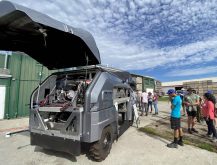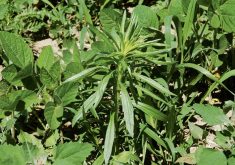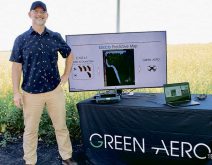Researchers are putting imaging technology to work to improve weed management practices.
Maor Matzrafi of the department of Plant Sciences at the University of California, Davis, has been evaluating the use of hyperspectral imaging technology to assess germination and herbicide response in Palmer amaranth.
Why it matters: Weed resistance to glyphosate, a broad spectrum herbicide, is spreading in Canada, resulting in yield losses and higher costs to farmers. These underline the need for new weed management solutions for farmers.
Imaging could be a new solution to the challenge of weed herbicide resistance that is emerging in North America, Australia and Europe, as well as Brazil and China, Matzrafi said in a presentation at the 2018 Canadian Weed Science Society annual conference in Niagara Falls.
“We’re in the precision ag phase (of crop protection) today with all sorts of sophisticated tools and sensors and cameras. Instruments are getting us to a place where we can look into problems and solve them,” he said, citing satellites, aircrafts, helicopters and drones as examples.

Those tools use different types of imaging technology ranging from RGB, which is what is in today’s cameras and cellphones, multispectral and hyperspectral technology to LIDAR, which illuminates a target with pulsed laser light and measures the reflected pulses with a sensor.
According to Matzrafi, a plant’s physiological and biochemical capabilities can be detected by hyperspectral or non-destructive methods and used to estimate seed germination and herbicide response.
Imaging is all about the light
“When we talk about imaging, we talk about measuring the light reflecting off objects,” said Scott Noble, an associate professor in the University of Saskatchewan’s College of Engineering.
“The incidence light hits the target, interacts with it, and we measure what comes back. We go from short UV (ultraviolet) waves at one end of the spectrum to thermal infrared at the long end.”

The main difference between multispectral and hyperspectral imaging is the number of bands and how narrow they are. Multispectral imagery generally contains three to 10 bands, whereas a hyperspectral image could have hundreds of thousands of bands.
When deciding what technology to use, said Matzrafi, it’s important to consider the number of bands needed and the target of detection. For example, on an image of a vegetable field at a height of 10 metres, some of the fruit on the plants will be visible, whereas an image at a height of 40 metres will show distances between crop rows or areas of pest infestation.
“Different wavelengths help distinguish between healthy and unhealthy plants, and as the wavelengths get higher, the differences (between them) become stronger,” he said.
Read Also

Senft to step down as CEO of Seeds Canada
Barry Senft, the founding CEO of the five-year-old Seeds Canada organization is stepping down as of January 2026.
Identifying weeds
Specific to weed science, the technology can be used to detect different crop types as well as identify healthy and unhealthy plants. At a more complex level, it can distinguish between wheat, soil, grass and broadleaf weeds.
Palmer amaranth has strong drought resilience, moving from complete dehydration to complete hydration in only 97 minutes, and is resistant to several modes of action, including glyphosate. A single plant can produce between 100,000 and 500,000 seeds with a 5C to 35C germination range. According to Matzrafi, this has led to yield losses of 77 per cent in cotton, 91 per cent in corn and 79 per cent in soybeans in the United States.
“These are massive plants and produce vast amounts of seeds. In Georgia, farmers are hand weeding Palmer amaranth because glyphosate resistance is such a problem; glyphosate is the only option for control,” he said.
When looking at seed germination, Matzrafi and his team used three populations of Palmer amaranth and imaged 40 seeds of each population before planting each one into an individual pot. Using hyperspectral imagery, they were able to distinguish between non-germinating and germinating seeds with an average accuracy rate of 80 per cent.
When testing herbicide resistance, the team completed spectrometer and photosynthesis measurements at the three- to four-leaf stage one day before herbicide application and again 21 days after application to assess response. They then categorized the plants according to sensitive, moderate response or resistant to herbicide application. Their results showed 86.5 per cent average accuracy on the full spectral range and 89.2 per cent on the visible spectral range.
“At the end, what is the next step — you have all this data, what do you do with it? We can help with predicting germination and herbicide response; this information can go into a decision-supporting system to help farmers with decision-making regarding weeds,” Matzrafi said. “Using this technology is cool, but this is what we want to get to: supporting farmer decisions.”




